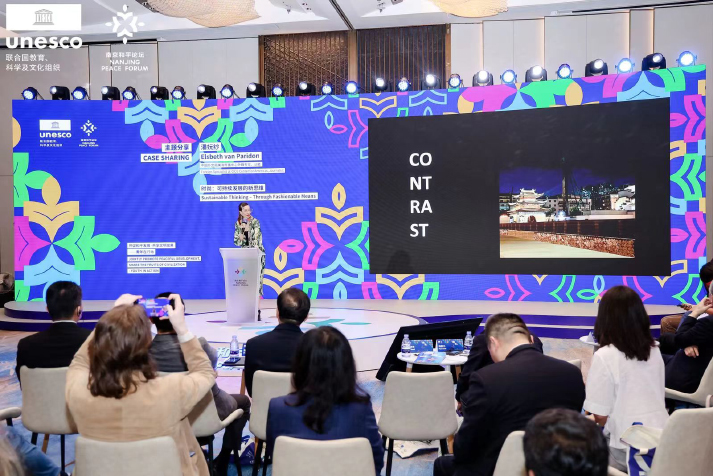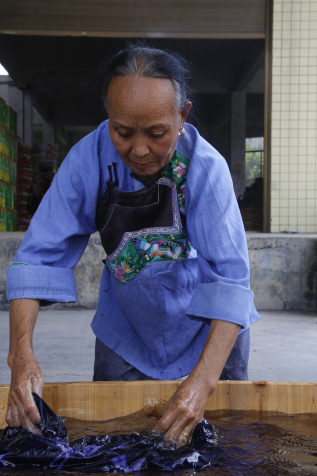| Lifestyle |
| Live a colorful life | |
|
|
 Beijing Review's Elsbeth van Paridon delivers a speech on sustainability at the Nanjing Peace Forum on September 20. The forum, which took place on September 19-20, was jointly organized by UNESCO, the National Committee of UNESCO of China, the Information Office of the Jiangsu Provincial Government and the Nanjing Municipal Government in Jiangsu Province (COURTESY PHOTO)
Nanjing, a collage of stark yet stunning contrast. Courtesy of the Touch Nanjing tour, I spent four days, from September 9 to 12, cruising through the city's green and leafy winding streets, sailing along its Yangtze River waters like the finless porpoise, and observing with fascination the way this once capital of the Middle Kingdom seamlessly weaves together ancient and contemporary, from architecture to thinking. Something I learned along the way is that the Nanjing section of the Yangtze River has served as a constant habitat for the endangered Yangtze finless porpoise, aka the only remaining freshwater dolphin in the Yangtze after the Baiji dolphin was declared functionally extinct in 2006. The Nanjing section features high-density areas for priority protection of said finless species—which by the way sports a very unique and sleek look. But we're not here to talk finless mammals. We're here to talk fashion—with a sprinkling of sustainability. EvoluSHEIN As a Beijing-based Dutch Sinologist and journalist, I explore China through the lens of fashion and urban culture. From Beijing to Shanghai, Shenzhen and Xinjiang Uygur and Tibet autonomous regions, China fashion and urban culture is a phenomenon that, particularly from the socioeconomic and anthropological perspectives, offers a whole new, soft-powered outlook on a society of over 1.4 billion people. I further hold a particular interest in the topics of the exploration of a new urban individuality and the power that is the New Youth in contemporary China. And that power extends to finless porpoises, or rather sustainability. As I was contemplating a fashionable, sustainable and local angle, I came across the following, and superbly befitting, fact: Online fast fashion retailer SHEIN was actually founded in the city of Nanjing, in 2008 by Chris Xu, a United States-born entrepreneur and search engine optimization specialist. Over the years, SHEIN went from being a low-cost Chinese apparel merchant to a global, online-only fashion juggernaut, climbing in sales from $10 billion in 2020, according to the Business of Fashion website, Bloomberg and TIME magazine, to a whopping $100 billion in 2022. But the globally immensely popular retailer in April announced its plans to become more focused on sustainability. Its evoluSHEIN line, for instance, is now offering customers the opportunity to go for more sustainable materials—and pay a premium for them. EvoluSHEIN items are partly made with recycled polyester. Now, this matters. And here's why. Since the 2000s, fashion production has doubled and it will likely triple by 2050, according to the American Chemical Society. The production of polyester, used for much cheap fast fashion, as well as athleisure wear—still one of the key trends among China's younger generations—has increased nine-fold in the last 50 years. Because clothing has gotten so cheap—we're all guilty of enjoying a spot of fast shopping on Alibaba's shopping Walhalla aka Taobao every now and then—it is easily discarded after being worn only a few times. Fashion is responsible for 10 percent of human-caused greenhouse gas emissions and 20 percent of global wastewater, and uses more energy than the aviation and shipping sectors combined. So, time we did something to rein in the oversized wardrobes. In other words, how to do a successful stint in fashion rehab?  Octogenarian Wang Qingxiang gives a Miao minority batik art master class in Huayuan County, Hunan Province, on August 19 (ELSBETH VAN PARIDON)
Très, très trashique The rise of sustainability in China's fashion industry has been driven by the country's Gen Z population, who are increasingly conscious about the environmental impact of their lifestyle choices as well as their bearing on society. This demographic is driving demand for sustainable and ethical fashion, with many young consumers opting for brands that prioritize eco- slash socio-friendly production methods and materials. In response to this trend, Chinese fashion brands are beginning to incorporate sustainable practices into their operations. We are entering a new era. The era where we all get très, très trashique wearing polyester recycled from plastic. I'm hereby referring to Chinese brands like JNBY, HowBottle and even sportswear champion Li Ning. The era when designers incorporate ethnic minority techniques. I'm hereby referring to anything from plant dyeing to embroidery making a coveted catwalk appearance or brands setting up full-fledged collabs with minority collectives, from local embroidery collectives in Hunan and Yunnan provinces to yak-wool-weaving collectives on the Qinghai-Tibet Plateau. But when you scratch the surface, you'll see that these collabs are not just about getting a new look; they are creating a whole new outlook for, for example, the minority collectives involved. Previous (Gen Z) speakers at this forum talked about their rural revitalization endeavors. They have ventured into the vast Chinese countryside to help locals hone their agricultural or artisanal skills and develop them into small business undertakings, like Miao farmers in Yunnan upping the local coffee game and taking it nationwide or teaming up with Miao batik artisans in Hunan and helping them livestream and sell their handmade works of wearable art to the world and in turn creating more income. More support plus more income are leading to more motivation and a pursuit of more and better education for the youngest generations. This is how a cycle of real sustainability is taking shape. Sustainability, at its finest, is about equity, diversity and inclusion. Unity in diversity China's younger generations are proving more open-minded and accepting of diversity, which in the fashionable framework has, for example, led to a rise in alternative subcultures such as streetwear and hiphop styles. When it comes to fashion, clashing patterns and colors can make, like Nanjing City, for the most wonderfully contrasting collage—because somehow, when thrown together, they seem able to cooperate instead of contradict. The same applies to people. Our differences do not necessarily have to be divisive. After all, opposites attract and can make for very peaceful unions—from couples to countries. Nanjing's Peace Monument—erected in honor of the more than 300,000 victims of the Nanjing Massacre which started when Japanese troops captured the city on December 13, 1937 and continued over the course of six atrocious weeks—serves as a reminder for all to be a little kinder to one another, a little more grateful for what we have and a little more aware of our (everyday) actions. So, in that light, here are few final words of modish wisdom: Live a colorful life. That's what liberty is for. The author is an editorial consultant with Beijing Review. This is an excerpt from her speech at the Nanjing Peace Forum on September 20 Comments to elsbeth@cicgamericas.com |
|
||||||||||||||||||||||||||||
|
